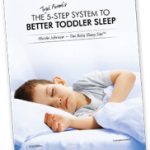
Understanding how your baby sleeps can help you get your baby to sleep through the night, take better naps, thrive, and be happier! Part of understanding how babies sleep is understanding how their sleep cycles work. This post will explain baby sleep cycles by age and provide a chart for guidance based on my 10+ years as a sleep consultant.
What is a Sleep Cycle?
It might seem like we adults simply fall asleep and then wake up in the morning. But, in reality, we go through different stages of sleep. In one “sleep cycle,” we go through four stages:
- Stage 1 is Non-REM sleep and some call it “twilight sleep.” If someone disturbs you during this stage, you might not even feel like you fell asleep and it’s quite easy to wake up. We typically only spend a few minutes in this stage.
- Stage 2 is also Non-REM and where we spend about half of our sleep. It is when our body temperature drops, our muscles begin to relax, and our eye movement stops.
- Stage 3 is also Non-REM and deep sleep. Consequently, it is difficult to wake someone up during this stage. We typically spend the most time in deep sleep in the first half of the night.
- Stage 4 is REM (Rapid Eye Movement) sleep and when most vivid dreams occur. REM sleep is considered “active” sleep when you might see limbs twitching whereas Non-REM sleep is considered “quiet sleep” when we look more peaceful. Even though we are dreaming, our muscles are paralyzed so we don’t act out those dreams. As the night progresses, we spend less time in Stage 3 and more time in Stage 4.
Although all people go through all of these stages of sleep, each night is different for each person. No two nights are the same nor do two people sleep the same. The amount of time you spend in each stage will vary throughout the night and change from night-to-night.
Babies also go through these stages but sleep cycles are different depending on age and are shorter.
How Are Sleep Cycles Different in Babies?
As you know, newborns typically sleep a lot, up to 16-18 hours a day. Newborns go immediately into REM sleep once they fall asleep and spend approximately 50% of their time in REM sleep. Therefore, it is why many newborns can sleep through noise. Since they spend 50% in REM and 50% in Non-REM deep sleep, it is often difficult to wake them. Because newborns are not going through the same four sleep cycles above, they typically sleep better and we get the old adage “sleeping like a baby.”
In reality, it should have been “sleeping like a newborn” because as your newborn grows, they start to sleep more like an adult. Babies begin to go into Non-REM sleep first and they go through the same four stages of sleep. This development begins around 3-4 months old and often leads to the 4 month sleep regression. It is between sleep cycles that a baby will have trouble staying asleep.
Because we are in deep sleep much of the time in the first half of the night, this often leads to babies sleeping through the night for 5-hour stretches fairly early. However, for the remainder of the night, they are cycling through the different stages and that’s where we start to see babies waking frequently at night.
How Long are Sleep Cycles in Babies?
While adult sleep cycles are usually around 90 minutes, babies have shorter sleep cycles. Baby sleep cycles are usually 40-50 minutes and vary by time of day and each night. This is often why babies take short naps. Catnapping is one of the most common complaints among new parents who visit this site.
Since children spend 1-2 hours in deep sleep, if your baby is waking at night, you might find they wake every 1-2 hours all night. This was the case for my son who inspired this website.
Also, we frequently hear from parents that their baby wakes even more frequently as we approach early morning. This is, again, because we spend a lot of time in deep sleep in the first part of the night. Therefore, 4:00 to 6:00 a.m. is often the most challenging for many families. A baby waking too early is one of the most common and difficult sleep problems to solve! Children who wake up after Stage 3 in the early morning are likely waking up crying whereas babies who enter Stage 4 before waking for the day wake up happy and refreshed.
Baby Sleep Cycles By Age Chart
Please Note: This chart has been developed based on research, anecdotal experience as a sleep consultant for nearly 15 years, and extrapolating that a child’s sleep cycle is around 40 minutes at 3 months old and extends to approximately 90 minutes by 5 years old.
When Do Baby Sleep Cycles Lengthen?
Your child’s sleep cycles will gradually lengthen from 40-50 minutes to 90 minutes by the time they are around 5 years old.
How Many Sleep Cycles Should a Baby Have?
Most babies need 10-12 hours of sleep so that would equal approximately 12-14 sleep cycles each night. At nap time, they typically have 1-3 sleep cycles depending on age and the time of day.
When Do Babies Connect Sleep Cycles for Naps?
At nap time, there are a variety of reasons that babies don’t connect sleep cycles. Between 2-3 months old, most babies take short naps to spread out their daytime sleep over more periods during the day since they can’t stay awake long. As your baby approaches 4 months, 5 months, and 6 months old, they will start to connect sleep cycles for naps and take at least two 1+ hour long naps.
When Baby Wakes After Their First Sleep Cycle
If your baby is waking up after their first sleep cycle, this likely means they have a scheduling problem. Review their sleep schedule for their age to make sure you aren’t keeping them awake too long before their nap or bedtime.
If your baby is waking up happy after a 40-minute nap, this might mean they feel refreshed and they need to be awake longer before their nap.
How to Connect Sleep Cycles
To help your baby connect sleep cycles, you will want to teach your baby to fall asleep on their own first and foremost. Be sure to review all of the most common napping mistakes to help your baby take longer naps.
If your baby is waking at night, be sure to learn ways to help your baby sleep through the night.
References:
https://www.sleepfoundation.org/baby-sleep/baby-sleep-cycle
https://www.sleepfoundation.org/stages-of-sleep
https://raisingchildren.net.au/babies/sleep/understanding-sleep/sleep-2-12-months
Solve Your Child’s Sleep Problems by Richard Ferber





